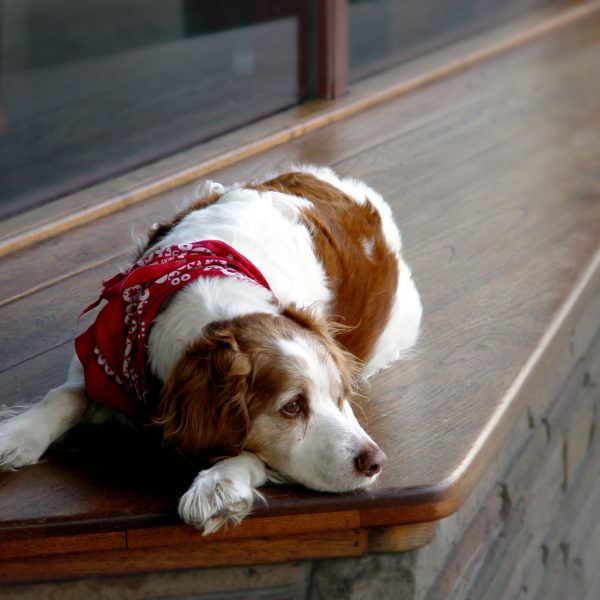What to do When Your Dog Has Separation Anxiety

When your dog has separation anxiety, they can often become disruptive and destructive when left alone. It can create a stressful situation for both of you. Your dog is stressed out, you are stressed out when you leave and come home, and it can cause a lot of other issues. Here’s what to do when your dog has separation anxiety:
How do you know your dog has separation anxiety?
First, you need to determine whether your dog has separation anxiety. It does tend to be more common in adopted dogs than puppies raised with a family because changes in ownership, abandonment, or changes in residence can cause separation anxiety. However, puppies who are not socialized enough or were raised without proper training and boundaries also develop symptoms of separation anxiety.
Common signs of separation anxiety include going to the bathroom inside the house, barking or howling, chewing or digging, pacing, and trying to escape when they are left alone. Anxiety can also cause dogs to grind their teeth. These are all symptoms of distress; they can also be signs of poor training or socialization. If your dog was never taught how to behave inside the home and boundaries were never established, they could be acting out because they simply don’t know any better or because they know acting out will get them attention.
If your dog is well-behaved and doesn’t exhibit these behaviors when you are around, it’s likely they have separation anxiety. The telltale sign is that they only exhibit these behaviors when you are getting ready to leave and when you are not around. In a family situation, a dog can sometimes become extremely attached to one person and will have separation anxiety when that person is not around even if they are surrounded by other family members.
What can you do when your dog has separation anxiety?
When your dog has separation anxiety, they fear being alone. If your dog is extremely attached to one person, they fear being without that person.
Counterconditioning
The first step towards helping your dog overcome separation anxiety is to start creating positive experiences with being alone so that they stop associating alone time with fear or anxiety. This is called counterconditioning and is easier said than done. Much like training, some dogs will pick up on the association quicker than others. Dogs with mild separation anxiety will be more receptive to counterconditioning. Rescue dogs with traumatic pasts or dogs who have been living with separation anxiety for several years will take more time and need a more complex approach to overcome the ingrained response.
Food can be a good starter for counterconditioning. Stuff a KONG toy with treats or food or get a puzzle toy you can fill with food and give it to your dog every time you leave the house. This will give the dog something entertaining and rewarding to do and will keep them occupied for 20 to 30 minutes. You will want to make sure the only time your dog receives these special toys is when you are gone. So, when you get home, remove them. Dogs with mild separation anxiety will start to associate this positive experience and high-value food with you leaving and it will no longer trigger a fear or anxiety response. This may not work for highly anxious dogs as they often do not eat when their favorite people are not around.
Counterconditioning and Desensitization
For dogs with moderate or severe separation anxiety, you will likely need the help of a trained and experienced professional – this is usually a Certified Applied Animal Behaviorist or a board-certified veterinary behaviorist. This approach requires counterconditioning as well as desensitization, which can be difficult to carry out successfully.
In general, you start with counterconditioning the behavior associated with pre-departure cues, which are the things you do before you leave that your dog has associated with you leaving. Once your dog no longer exhibits an anxiety response for those, then you work on gradually extending how long your dog is alone. You start with very short departures, where you return before your dog starts to become upset. Then, slowly increase the amount of time your dog is alone. It is very important that your dog does not experience a full-blown anxiety reaction during these sessions; otherwise, your dog can become even more frightened instead. This means a lot of positive rewards and patience; it also means your dog cannot be left alone outside of the desensitization sessions.
Crate training can be helpful during this process, but only if it does not cause further anxiety in your dog. They need to view their crate as a safe space. If crate training or being crated causes an anxiety response in your dog, it cannot be used for counterconditioning or desensitization sessions. Because this process is focused on getting the dog gradually accustomed to being alone, it can be slow and time-consuming. It’s a lot of work, but it’s well worth it to ensure your pup feels safe even when you aren’t around.
There are several common fears and phobias in dogs and separation anxiety is one of them. Separation anxiety isn’t fun for anyone, but there is hope. If you’re bringing a puppy into your family, the best thing you can do is implement training and obedience classes and plenty of socialization throughout their life. This ensures your puppy grows into a confident, mature dog who loves being with you and is also comfortable with some alone time.
